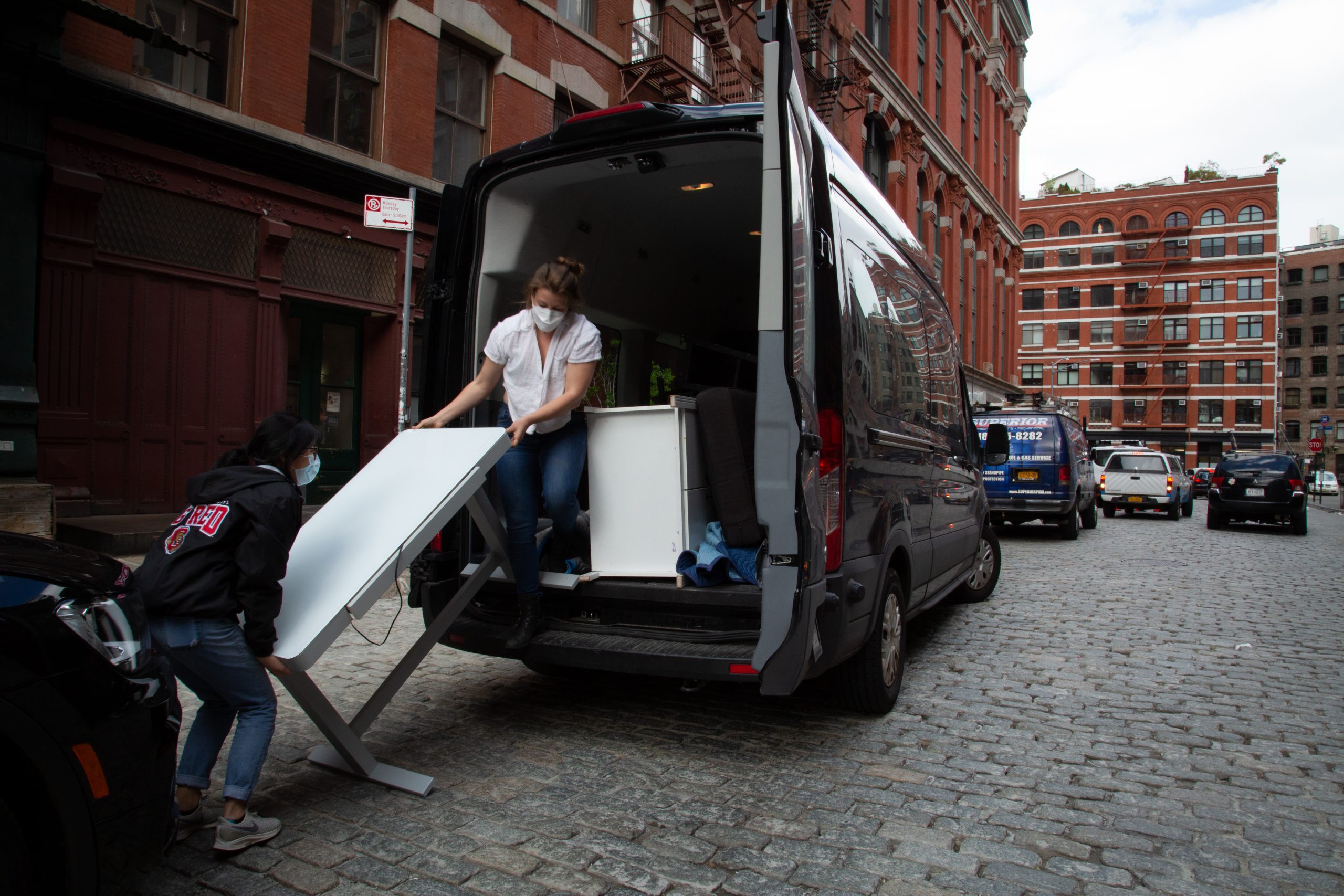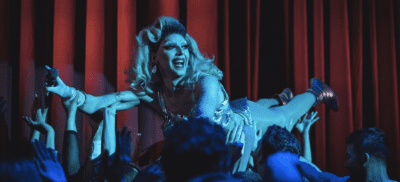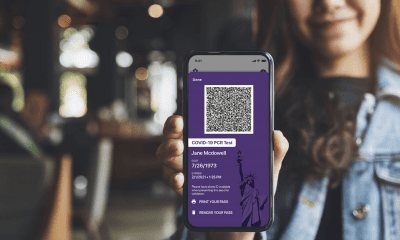One person’s trash is this woman’s calling
Shelby Veazey has spent the past year collecting NY's finest discarded items and finding them new homes—for a small fee
Crossing the Williamsburg Bridge, Shelby Veazey sings along to “Black Truck” by Mareba. The windows are down, ruffling the pages of “Black Wall Street,” the book by Hannibal B. Johnson that she keeps on her dashboard, and sending up clouds of dog hair. She moves around traffic fluidly, as if she weren’t driving a 19-foot black Ford transit van full of furniture.
“I wanted to save this song for the bridge ‘cause it’s my jam,” she says over the music. “It’s about just doing you.”
Veazey, 30, has been on the road since 8 a.m., sweeping New York City for cast-off furniture on its sidewalks, scooping it up and delivering it to new homes—for a fee. She’s been doing this for eight months, since she started a company called Stoober.
“It stands for stoop-to-stoop Uber,” an idea that came to her on a long drive. Veazey drives five days a week, “seven sometimes actually,” making about 10 deliveries a day.
Most deliveries go for a flat rate: $40. For bulkier items—sectional sofas, say—she charges $60. The service operates on her Instagram page, where Veazey uploads photos of her street-side treasures to 11,000 followers. The first person to request the item gets 10 minutes to respond through direct messaging before the find goes to the next person in line.
“A big piece of this is social access and redistributing wealth, to really give equal opportunity to everyone on my page,” she says. “I’m rooting for everybody.”
Veazey shares her account with Erin Henry, her social media manager and first employee. “I truly don’t know what I’d do without her,” she says. Henry, hired in January, handles hundreds, sometimes thousands of messages a day. In Veazey’s phone, Henry’s contact name is “God.”
Steady stoopin’
As Veazey steers down Seventh Avenue in Manhattan, the back of the van rattles with dressers, desks and couches piled atop each other. But Veazey keeps looking for more, her head swiveling a dozen times in a block, the bun on her head flopping back and forth.
“I’ve got the stoob eye,” she says.
Sometimes it’s hard to turn that off. “I really try to when I’m going out with friends. But they can see it, and will ask me to stop,” she laughs. “I tell them ‘Okay, I’ll come back in the morning.’” But she’s been known to ride home on the subway in the early hours carrying a chair or a lamp.
Before Stoober, Veazey had spent four years as an energy consultant for small businesses. Even before the pandemic, though, she felt limited; constricted budgets and priorities never resulted in the environmental impact she hoped for. Last summer, when she began to notice valuable items left on curbs throughout the city, she wanted to do more.
“There’s only so far you can go,” as a consultant, she says. “This is a more obvious waste solution. It’s more connected to the actual residents, which really conditions small businesses to make changes too.”
Stoober has gone from side-hustle to full-time job. She bought her van in September, and added another this year. She calls them “the sisters” and parks them on the crowded block outside of her studio in Bed-Stuy, Brooklyn where she lives with her pointer mix, Brutus.
“A good day is when I can park the sisters together,” she says.
At Seventh and 22nd Street, she spots a white hutch and lights up. “Oh my goodness! Wait, we’re going to have to go there.”
She pulls over and approaches the hutch, maneuvering between piles of trash bags, phone already in hand to shoot a video.
“It’s not even that bad,” she says, opening the cabinet. “The bottom is a little broken but it’s an Ikea piece. It’s perfect.” Passersby slow down to watch as she carefully loads it in the back next to a storage cabinet from Williamsburg.
Back in the van, she takes a moment to think of an Instagram caption, coming up with: “Get this hutch, this b*tch is clutch, fits it in the van, it doesn’t weigh that much.” She lists it for $40 and uploads the video to her story.
“I’m just shocked by the amount of waste and the things that people will try to throw away,” she says.
The New York metropolitan area produces 33 million tons of waste per year, an international group of academics estimated in 2015—more than any other megacity in the world. And the pandemic hasn’t helped: Garbage surged last summer, the city’s Department of Sanitation has reported.
“The department had a budget crunch with Covid,” explains Steve Changaris, vice president of the northeast region of the National Waste and Recycling Association, which represents private sector waste and recycling services. “And they had around 600 infections,” meaning the department had fewer people on hand for street cleaning and garbage collection.
In that time, the volume of street-side trash in residential areas rose 5 to 7 percent, while the volume outside commercial sites decreased.
“The residential volume went up because people are at home, they’re not at work. They’re ordering take out, they have more kids at home,” Changaris says.
Veazey has noticed that a lot of the items left at the curb were valuable.
“It made me angry,” she says. “Not at the people, but at the system. There hasn’t been a proper set-up for New Yorkers to do the right thing.”
Most mornings, she gets up early to beat the garbage men. Some nights, she doesn’t come home until 10 p.m. or later. “I’m just trying to remove the option to trash something.”
Most of the items she salvages originally went for at least $500, she estimates. The most expensive thing she’s ever delivered was an acrylic chair that a customer claims to have seen for $2,000.
She finds many of her treasures on the Upper West and East Sides, and Williamsburg—all neighborhoods with higher than median household income, according to NYU Furman Center.
“Those with more disposable income have more disposable furniture,” she says.

Good haul (Gabriella Canal)
‘Should I pick that up?’
At a red light, her phone lights up with a dozen notifications for the hutch. She swipes them away—”it’s in ‘God’s’ hands now”— and scrolls through another Instagram account, Stooping NYC, where many of her customers find discarded furniture and alert Veazey. She pauses at a gray Victorian style loveseat, reportedly outside 36 East 10th St. and shares it to her story.
“Should I pick that up?” she wonders, heading that way.
She wants to launch a website where she could list her inventory and host transactions.
“I have a lot of ideas. But,” she says, “I’m at capacity.”
When she pulls up to 36 East 10th St, the loveseat is gone.
Emotional Oranges
Later, outside 11 Harrison in Tribeca, Veazey is helping Joanna Li lift a heavy desk into the van. She assures Li she’s never been unable to fit something in. Li, who just moved to Midtown from New Jersey, had been working virtually from her bed, using a trash can for a desk. When she noticed that an office building was selling desks—its workforce had become permanently remote—she found Veazey on Instagram and messaged for a personal pick up.
This is another Stoober’s offering: managing personal deliveries, a solution for those who don’t want to drive a van in the city.
Veazey offers Li a ride home, something she rarely does.
She shouts to Li in the back, “I always ask somebody for a song, Joanna.” “Oh man. Do you know Emotional Oranges?”
“I don’t.”
“The song is called ‘West Coast Love’.”
Veazey plays the track and adds it to her personal Spotify playlist called “Stoober,” 28 hours of music from reggaeton to rock, each song a recommendation from a customer.
“Have you met a lot of people through this?” Li asks.
“A bunch. Everyone is exciting, gracious, kind.”
Veazey helps Li lug the new desk to the door, with Li’s thanks. She hauls herself back up into the van and blasts her playlist as she drives downtown to her next stop.
You might also like 


























